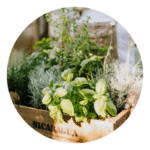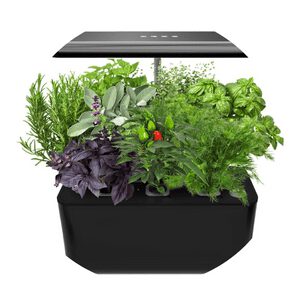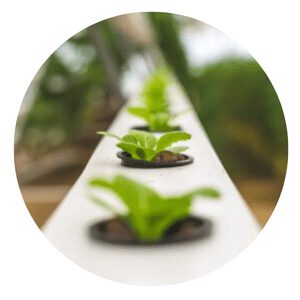What Herbs Are Good For Hydroponics?
Herbs are one of the most versatile and easy to grow plants in hydroponics.
They can be grown in a small space and don’t require much care.
Herbs can be used for cooking, medicinal purposes, or as ornamental plants.
Some of the most popular herbs for hydroponics are basil, chives, cilantro, and mint.
Hydroponic Herbs Menu
What is hydroponics?
Hydroponics is a method of growing plants in water without soil.
The roots of the plant are suspended in a solution of water and nutrients, and the plant is given light and air just like it would receive if it were growing in soil.
Hydroponics can be used to grow any type of plant, but it is most commonly used to grow fruits, vegetables, and herbs.
The main benefit of hydroponics is that it allows plants to be grown in places where soil is not present, such as on rooftops or in deserts.
In addition, because hydroponic plants do not have to contend with soil pests or diseases, they often grow more quickly and produce more fruit than plants grown in soil.
The benefits of herbs in hydroponics
Herbs are a great addition to any hydroponic garden.
Not only do they add flavor and interest to your plants, but they can also have a positive effect on your overall health.
Here are just a few of the benefits that herbs can provide:
1. Herbs can help purify the air in your home or office.
2. They can also help improve your digestion and metabolism.
3. Herbs can even boost your immune system and help fight off diseases.
4. In addition, herbs can help you relax and reduce stress levels.
5. Finally, herbs can add a splash of color and beauty to your hydroponic garden.
The best herbs for hydroponics
Herbs are a great addition to any hydroponic garden.
Not only do they add flavor and aroma to your food, but they can also provide many health benefits.
Here are some of the best herbs for hydroponics:
When you want to grow herbs but don't have a lot of space, try hydroponics! With hydroponics, you can grow herbs indoors all year long. You don't need soil, just water and nutrients. Herbs will thrive and you'll have a bountiful harvest.
Chappy The Gardener
Basil
If you’re interested in growing your own herbs, you may be wondering if hydroponics is a good option.
While there are many benefits to growing herbs hydroponically, there are also some challenges.
Here are some tips to help you get started:
1. Start with a small setup. It’s easy to get overwhelmed when starting out with hydroponics, so it’s best to start small. A simple setup will help you get a feel for the basics without being too complicated.
2. Choose the right plants. Not all plants do well in hydroponic systems, so it’s important to choose ones that are suitable.
Basil is a great option for beginners as it’s relatively easy to grow and doesn’t require too much attention.
3. Get the nutrient balance right.
Mint
Mint is a popular herb that has many uses, both culinary and medicinal.
Did you know that mint can also be grown hydroponically?
Here are some tips to help you grow mint hydroponically:
1. Choose a container that is at least 12 inches deep. Mint roots can grow quite long, so you will need a deep container to accommodate them.
2. Fill the container with a quality hydroponic growing medium. Coconut coir or perlite are both good choices for mint.
3. Water your mint plants regularly, keeping the growing medium moist but not soggy.
4. Place your mint plants in a bright location, but out of direct sunlight. A south-facing window is ideal.
5.Harvest your mint leaves when they are young and tender for the best flavor.
Sage
If you’re looking to add some flavor to your hydroponic garden, sage is a great option.
This herb is easy to grow and can be used in a variety of dishes.
Here are a few tips to help you get started:
1. Choose a well-lit spot for your sage plants. They need at least six hours of sunlight per day.
2. Sage can be grown in both soil and hydroponic systems. If you’re using hydroponics, make sure the roots have plenty of room to spread out.
3. Water sage plants regularly, keeping the soil or growing medium moist but not wet. Allow the top inch or so of soil to dry out between watering.
4. Fertilize sage plants every two weeks with a water-soluble fertilizer designed for herbs or vegetables.
Rosemary
If you’re thinking of growing herbs hydroponically, rosemary is a great option.
Here are some tips to get you started:
1. Start with a well-draining hydroponic system. Rosemary doesn’t like to have its roots sitting in water, so make sure your system has good drainage.
2. Keep the temperature on the cooler side. Rosemary prefers cooler temperatures, so aim for 60-70 degrees Fahrenheit.
3. Give your plants plenty of light. Rosemary needs at least six hours of direct sunlight per day to thrive.
4. Use a nutrient-rich growing medium. A good option for rosemary is coco coir or vermiculite mixed with perlite.
Oregano
If you’re thinking of growing herbs hydroponically, oregano is a great option.
Not only is it easy to grow, but it’s also a versatile herb that can be used in a variety of dishes.
Here are a few tips to help you get started:
1. Start with a small container. Oregano doesn’t require a lot of space, so a small grow pot or tray will do.
2. Use a well- aerated soil mix. Herbs need lots of oxygen to thrive, so make sure your soil mix is light and airy.
3. Give your oregano plenty of light.
Dill
Dill is a great herb to grow hydroponically because it doesn’t require a lot of space. It can be grown in a small container or even on a windowsill.
Dill is also relatively easy to care for and doesn’t require a lot of attention.
To get started, you’ll need to purchase dill seeds or starts from a garden center or online retailer.
Once you have your seeds or starts, plant them in a well-draining soilless mix. Water your dill regularly, making sure the soil stays moist but not soggy.
Dill will be ready to harvest in about 60 days. Cut the leaves as needed, being careful not to damage the plant.
Thyme
Hydroponic thyme is an easy and versatile herb to grow indoors.
Here are a few tips to get the most out of your hydroponic thyme:
1. Start with a high-quality seed or cutting. This will ensure that your plant is healthy and vigorous from the start.
2. Provide plenty of light. Thyme loves sunlight and will do best if it receives at least six hours of direct sunlight per day. If you are growing thyme indoors, make sure to place it near a bright window or under grow lights.
3. Keep the roots moist but not waterlogged. Water your thyme regularly, but make sure the roots are not sitting in water for extended periods of time. This can lead to root rot and other problems.
4. fertilize monthly with a balanced liquid fertilizer .
Tips for growing herbs in hydroponics
Herbs are a fantastic addition to any hydroponic garden.
Not only do they add flavor and interest to your plants, but they can also help deter pests and improve the overall health of your garden.
Here are a few tips for growing herbs in hydroponics:
1. Start with high-quality seeds or transplants. This will give you the best chance for success.
2. Make sure your hydroponic system is well-aerated. Herbs need plenty of oxygen to thrive.
3. Keep an eye on your pH levels. Most herbs prefer a slightly acidic environment, so aim for a pH between 6 and 7.
4. Fertilize regularly with a high-quality organic fertilizer. This will help ensure that your plants get all the nutrients they need to grow healthy and strong.
The Different Types of Hydroponics Systems
Hydroponics is a type of gardening that uses no soil, but instead grows plants in water that is enriched with nutrients.
There are many different types of hydroponics systems, each with its own advantages and disadvantages.
The most common type of hydroponics system is the flood and drain system.
In this system, the roots of the plants are constantly submerged in water, and then the water is drained away. This cycle is repeated several times a day.
The advantage of this system is that it provides a constant supply of oxygen to the roots of the plants.
The disadvantage is that it can be difficult to control the amount of water and nutrients that the plants receive.
Another type of hydroponics system is the drip system.
In this system, a nutrient-rich solution drips slowly onto the roots of the plants.
How to Build Your Own Hydroponics System
If you’re interested in growing your own herbs, vegetables, and fruits, then you might want to consider building your own hydroponics system.
Hydroponics is a method of growing plants without soil, using only water and nutrients.
This type of gardening is ideal for small spaces, such as apartments or balconies.
Plus, it’s a great way to get started with gardening if you don’t have much experience.
Here are some tips on how to build your own hydroponics system:
1. Choose the right location. Pick a spot that gets plenty of sunlight and is easy to access so that you can tend to your plants easily.
2. Gather your supplies. You’ll need a container (like a plastic storage bin), grow lights, an air pump, tubing, net pots, and hydroton clay pellets.
3. Find a place to add drainage. At the bottom of your container, drill several holes and insert the tubing. This will allow excess water to drain out of the container.
4. Add the clay pellets. These will act as the growing medium.
5. Add the net pots. These should be filled with the clay pellets and placed over the tubing in order to hold your plants.
In conclusion,hydroponics is a great way to grow herbs.
With hydroponics, you can control the amount of water and nutrients that your plants receive, and you can also control the environment in which they grow.
By growing herbs hydroponically, you can have fresh herbs all year round.
Hydroponic FAQ
Hydroponics is a method of growing plants in a water-based solution. The roots of the plant are submerged in the solution, which provides nutrients to the plant. Hydroponics can be used to grow plants in any environment, including indoors or in areas with limited space.
Hydroponics is a great way to grow plants without using soil. Soil can contain harmful bacteria and pests that can damage plants. Hydroponics also allows for better control over the nutrient levels that plants receive. This means that plants can be grown faster and more efficiently.
Hydroponics is not only for professional growers anymore. Anyone can set up a simple hydroponic system at home with just a few supplies. All you need is a container, some water, and some nutrients for your plants. You can find all of these supplies at your local garden center or online.
Hydroponics is a method of growing plants in a water-based solution instead of soil. The roots of the plants are suspended in the solution, which is typically kept at a pH level between 5.5 and 6.5 and contains all the nutrients the plant needs to grow.
The water-based solution is circulated using a pump, and the oxygen in the water helps the roots to absorb the nutrients they need. The plants are grown in a controlled environment, which means that they can be grown year-round and don’t require as much space as traditional methods of farming.
Hydroponics is a efficient way to grow crops, and it’s often used by commercial growers to produce fruits, vegetables, and herbs.
Hydroponics is a type of gardening that uses mineral nutrient solutions, in water, without soil. Terrestrial plants may be grown with only their roots exposed to the mineral solution, or the roots may be supported by an inert medium, such as perlite or gravel. The main advantages of hydroponics over conventional farming are:
1) Hydroponics can be done on a smaller scale than traditional farming. This means that it is possible to set up a hydroponic system in your own home, without needing a lot of space.
2) Hydroponics does not require the use of chemical pesticides or herbicides. Because the plants are grown in a controlled environment, they are not subject to pests and disease in the same way that plants grown in soil are.
Hydroponics is a method of growing plants in water without soil. Although this type of gardening has many advantages, there are also some disadvantages to consider before starting a hydroponic garden.
One of the biggest disadvantages of hydroponics is the initial cost. Setting up a hydroponic system can be expensive, and it requires special equipment that may not be readily available. Additionally, hydroponic gardens require more maintenance than traditional gardens and may require additional expertise to troubleshoot problems.
Another downside to growing plants hydroponically is that they can be more susceptible to diseases and pests. Because the roots are exposed and the plants are grown in close proximity to each other, diseases can spread quickly throughout a hydroponic garden. Pests can also be difficult to control in a hydroponic system because they can easily hide among the plants.
Hydroponics is a gardening method where plants are grown in water instead of soil. The water is kept circulating and contains all the nutrients the plant needs to grow. You can set up a hydroponic system using different materials, but you will need some basic equipment to get started.
To start growing plants in a hydroponic system, you will need:
-A container to hold the plants and water. This can be anything from a plastic bucket to a fish tank.
-A way to circulate the water and deliver nutrients to the plants. This can be done with a simple pump and tubing or with a more complex aeration system.
-Grow lights if you are not growing your plants in natural sunlight.
-Plant food or nutrient solution to mix into the water.
A hydroponic system is a great way to grow plants without using soil. There are many different ways to set up a hydroponic system, but they all generally follow the same basic principles.
One of the most important things to consider when setting up a hydroponic system is the type of growing medium you will use. There are many different types of growing mediums available, and each has its own advantages and disadvantages. Some common types of growing mediums include gravel, sand, perlite, and vermiculite. Once you have decided on a type of growing medium, you will need to purchase enough to fill your chosen container.
Another important consideration when setting up a hydroponic system is the type of nutrient solution you will use. There are many different types of nutrient solutions available, and each has its own advantages and disadvantages.
Click To Grow
Helps Us Grow – Share If You Like
















